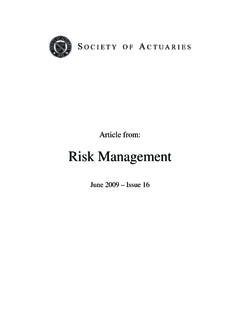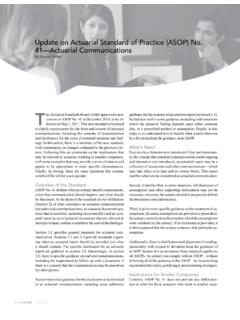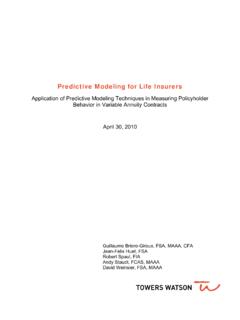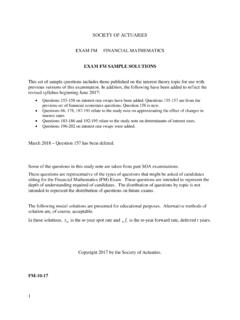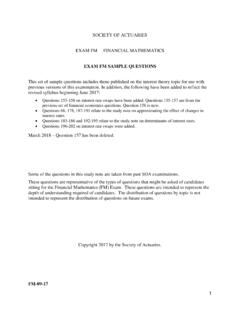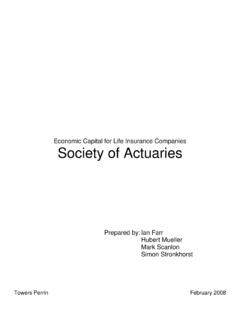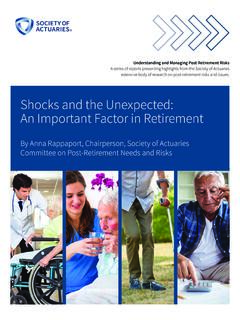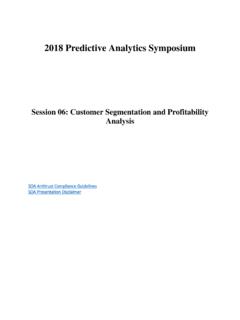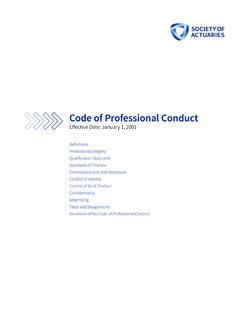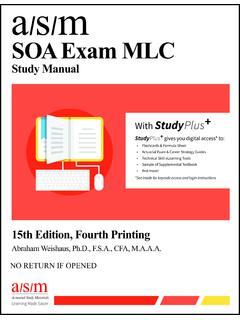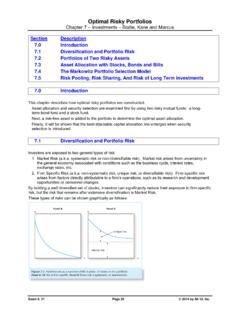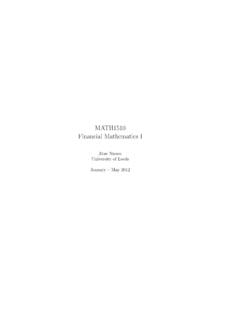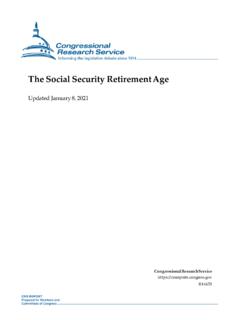Transcription of Short-Term Actuarial Mathematics Exam—October 2021
1 Short-Term Actuarial Mathematics Exam october 2021 The Short-Term Actuarial Mathematics exam is a three-and-a-half hour exam that consists of 35 multiple-choice questions and is administered as a computer-based test (CBT). For additional details on CBT, please refer to Exam Rules. The syllabus for this examination provides an introduction to modeling and covers important Actuarial methods that are useful in modeling. It will also introduce students to the foundational principles of ratemaking and reserving for Short-Term coverages. A thorough knowledge of calculus, probability, and mathematical statistics is assumed. The candidate will be introduced to a variety of frequency, severity, and aggregate models that are useful for Short-Term Actuarial applications.
2 The candidate will learn the steps involved in the modeling process and how to apply these steps. The candidate should be able to: 1) analyze data from an application in a business context; 2) determine a suitable model including parameter values; 3) provide measures of confidence for decisions based upon the model; and 4) estimate losses using credibility procedures. The candidate will be introduced to a variety of tools for the calibration and evaluation of the models. In addition, the candidate will gain a basic understanding of insurance and reinsurance coverages for Short-Term insurances. In the context of such coverages, the candidate will become familiar with various techniques utilized in calculating loss reserves and rate changes.
3 A variety of tables are available below for the candidate and will be provided to the candidate at the examination. These include values for the standard normal distribution, chi-square distribution, and abridged inventories of discrete and continuous probability distributions. Candidates will not be allowed to bring copies of the tables into the examination room. Check the Updates section on this exam's home page for any changes to the exam or syllabus. In the learning outcomes, weights have been provided to indicate the relative emphasis on different sections. The ranges of weights shown are intended to apply to the large majority of exams administered.
4 On occasion, the weights of topics on an individual exam may fall outside the published range. Candidates should also recognize that some questions may cover multiple learning outcomes. Each multiple-choice problem includes five answer choices identified by the letters A, B, C, D, and E, only one of which is correct. Candidates must indicate responses to each question on the computer. As part of the computer-based testing process, a few pilot questions will be randomly placed in the exam (paper and pencil and computer-based forms). These pilot questions are included to judge their effectiveness for future exams , but they will NOT be used in the scoring of this exam.
5 All other questions will be considered in the scoring. All unanswered questions are scored incorrect. Therefore, candidates should answer every question on the exam. There is no set requirement for the distribution of correct answers for the multiple-choice preliminary examinations. It is possible that a particular answer choice could appear many times on an examination or not at all. Candidates are advised to answer each question to the best of their ability, independently from how they have answered other questions on the examination. 2 Because the CBT exam will be offered over a period of a few days, each candidate will receive a test form composed of questions selected from a pool of questions.
6 Statistical scaling methods are used to ensure within reasonable and practical limits that, during the same testing period of a few days, all forms of the test are comparable in content and passing criteria. The methodology that has been adopted is used by many credentialing programs that give multiple forms of an exam. Recognized by the Canadian Institute of Actuaries. LEARNING OUTCOMES 1. Topic: Severity Models ( ) Learning Objectives The Candidate will understand and be able to perform calculations with commonly used severity models. Learning Outcomes The Candidate will be able to: a) Calculate moments, percentiles, and generating functions.
7 B) Describe how changes in the parameters affect the distribution. c) Recognize classes of distributions, including extreme value distributions, and their relationships. d) Create new distributions by multiplication by a constant, raising to a power, exponentiation, and mixing. e) Identify the applications to which each distribution may apply and explain why. f) Apply the distribution to an application, given the parameters. g) Compare two distributions based on various characteristics of their tails, including moments, ratios of moments, limiting tail behavior, hazard rate function, and mean excess function. 3 2. Topic: Frequency Models ( ) Learning Objectives The Candidate will understand and be able to perform calculations with commonly used frequency models.
8 Learning Outcomes The Candidate will be able to, for the Poisson, mixed Poisson, binomial, negative binomial, and geometric distributions, and mixtures thereof: a) Calculate moments and generating functions. b) Describe how changes in the parameters affect the distribution. c) Recognize classes of distributions and their relationships. d) Identify the applications to which each distribution may apply and explain why. e) Apply the distribution to an application, given the parameters. f) Derive and perform calculations with the zero-truncated and zero-modified versions of these distributions. 3. Topic: Aggregate Models ( ) Learning Objectives The Candidate will understand and be able to perform calculations with aggregate models.
9 Learning Outcomes The Candidate will be able to, for aggregate risk models: a) Define collective and individual risk models and calculate their expectation and variance. b) Use the normal distribution to approximate the aggregate distribution. c) Use the recursive formula to calculate the values of the collective risk models with discrete distributions of severities. d) Calculate the expected aggregate payments in the presence of an aggregate deductible. e) Evaluate the effect of the coverage modifications on the expected aggregate payments. f) Perform the exact calculation of aggregate loss distribution in case of the normal distribution of severities, exponential and gamma (Erlang) distribution of severities and a compound model with negative binomial frequency and exponential distribution of severities.
10 4 4. Topic: Coverage Modifications ( ) Learning Objectives The Candidate will understand and be able to perform calculations with respect to coverage modifications. Learning Outcomes The Candidate will be able to, for frequency, severity, and aggregate models: a) Evaluate the effect of coverage modifications, in particular, deductibles, limits, and coinsurance. b) Calculate loss elimination ratios and increased limits factors. c) Evaluate the effects of inflation on losses. 5. Topic: Risk Measures ( ) Learning Objectives The Candidate will understand and be able to perform calculations with common risk measures. Learning Outcomes The Candidate will be able to: a) Calculate Value at Risk and Tail Value at Risk.
